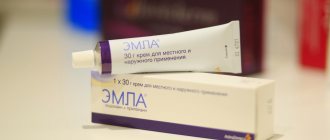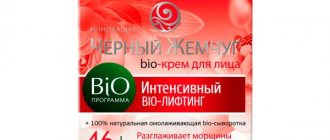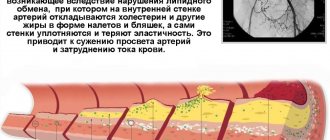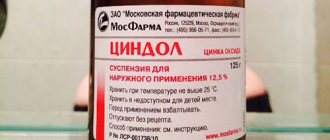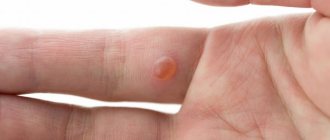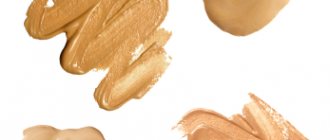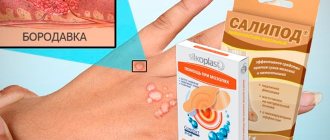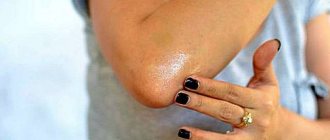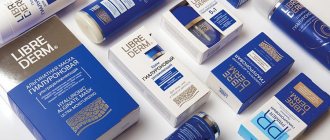Composition and release form
Emla anesthetic cream is a drug used as local anesthesia, the effectiveness of which is due to a complex of analgesics, mainly lidocaine and prilocaine. The compounds are able to penetrate the layers of the dermis and anesthetize the skin area. It is available in aluminum tubes of 5 and 30 g. And also in a 5x5 box, that is, 5 tubes of 5 grams each, special stickers are inserted into it, under which the cream is applied.
Contains: lidocaine – 25 mg. per 1 g., prilocaine – 25 mg. for 1 gr. and excipients: Arlaton 289 – 19.0 mg, Carbomer 974R – 10.0 mg, sodium hydroxide and purified water. The maximum concentration of the active substance occurs after 4 hours. The anesthetic effect lasts for 2 hours after applying the cream. Does not have a bacterial or healing effect.
Overdose
If the recommended dosage regimen is followed, the development of signs of systemic toxicity is unlikely. Symptoms of intoxication are likely the same as with other local anesthetics, such as central nervous system (CNS) stimulation and, in severe cases, CNS and cardiac depression.
In rare cases, children have developed clinically significant methemoglobinemia.
Prilocaine in high doses can cause an increase in methemoglobin levels.
Superficial application of prilocaine 125 mg for 5 hours caused the development of moderate methemoglobinemia in a 3-month-old child. Superficial application of lidocaine at a dose of 8.6-17.2 mg/kg caused serious intoxication in newborns.
Treatment
Severe neurological symptoms (convulsions, depression of the central nervous system) require symptomatic treatment, including the prescription of anticonvulsants and, if necessary, artificial ventilation. In case of development of methemoglobinemia, the antidote is methylthionium.
Due to the slow systemic absorption of the drug, patients should be monitored for several hours after starting treatment for intoxication.
Interaction with other drugs and other types of interactions
In patients receiving drugs that induce the development of methemoglobinemia (for example, drugs containing a sulfo group), EMLA cream may help increase the concentration of methemoglobin in the blood.
When treating with other local anesthetics and structurally similar drugs (including tocainide), the risk of increased systemic effects should be taken into account when using high doses of EMLA cream
No specific studies have been conducted to evaluate the interaction of lidocaine/prilocaine with class III antiarrhythmic drugs; caution should be exercised when using drugs together. Pharmaceutical interactions: not detected
Pharmaceutical interactions: not detected
No specific studies have been conducted to evaluate the interaction of lidocaine/prilocaine with class III antiarrhythmic drugs; caution should be exercised when using drugs together. Pharmaceutical interactions: not detected
Advantages and disadvantages
Emla is widely used in medicine, as well as in cosmetology. Many women have already appreciated its benefits, using it for pain relief before hair removal at home or before going to a beauty salon.
Advantages:
Flaws:
Emla cream is used not only in cosmetology, but also in medicine when performing minor but painful procedures: injections, childhood vaccinations, minor surgical interventions.
Precautionary measures
When applying the cream to the skin, you may experience a burning sensation, slight warmth, paleness or, conversely, redness of the application site. These symptoms are short-lived and mostly go away on their own.
Carefully! If the disturbing symptoms do not decrease, but rather intensify, pain, itching, swelling, and irritation occur - this indicates an allergic reaction. In this case, it is necessary to remove the cream by rinsing the application area with plenty of water.
According to the instructions for use, the cream cannot be used for:
- hypersensitivity to some components of the drug;
- any violations of the integrity of the skin, damage. The exception is trophic ulcers;
- methemoglobinemia (increased levels of methemoglobin in the blood).
When applying the cream, avoid the eye area, due to the likelihood of irritating and damaging effects on the cornea.
If the substance gets on the mucous membranes of the eyes, they must be immediately rinsed with copious amounts of water. You should also avoid getting the drug into the auricle, due to the risk of possible penetration of the substance into the middle ear.
Important! Before using Emla cream, if you have any diseases or are taking medications, it is recommended to consult a specialist.
Application Features
The drug is intended for external use only. It is not recommended to use Emla cream for treating the ear and eye areas.
Applying Emla cream before epilation of the bikini area and sugaring is carried out in two stages:
- The cream in an amount of 3-4 grams is applied to the mucous membrane of the labia, after 5-10 minutes the hair is removed.
- Directly on the skin. The drug should be applied in a thick layer to the entire area where hair removal will be performed, covered with film and left for 1–1.5 hours. Then wipe dry with a paper napkin or towel and begin epilating your bikini.
On other parts of the body, it is better to act in one stage: apply a thick layer and leave for an hour under cling film - if the area is large, or under a special sticker that is included in the package with the cream - if the area is small. A bandage is usually applied for pain relief during surgery. In this case, the effect of the cream lasts from 2 to 5 hours.
Consumer Reviews
The cream found many fans from the female audience who were faced with epilation of intimate areas. Like any product, Emla has advantages and disadvantages.
- Evgenia (Moscow) is satisfied with the effect of the cream and claims that she felt virtually no pain during laser hair removal. The disadvantage is considered to be the high cost and long waiting time for the analgesic effect.
- Vera (Rostov-on-Don) notes a loss of sensitivity of the dermis by 1 cm in depth. She talks about the cost-effectiveness of using the ointment: 5 g for 2 sessions of waxing hair in the intimate area.
- Natalya (Perm) is upset that the effect of the anesthetic lasted only 30 minutes and caused severe irritation on the skin.
- Larisa (Izhevsk) says that she was afraid of pain before using the product for the first time, and now she does sugaring on her own at home. Notes the high price and rapid consumption of the ointment.
| Rescue from “undesirable vegetation” has been found! Hair disappears absolutely everywhere quickly, painlessly, for a long time! Read details >>> |
| Liquid Laser depilatory product The effect is comparable to laser hair removal after just a few uses! Read more >>> |
| Remedy No. 1 for getting rid of unwanted hair Creates the effect of photoepilation, removes hair without pain and suffering Find out more >>> |
Contraindications
p class=”spisok”>Emla cream has a number of contraindications:
- allergy to the composition of the cream;
- premature babies and infants up to one year;
- glucose intolerance;
- breast-feeding;
- the presence of scratches, wounds, ulcers on the skin.
Side effects when applying the ointment occur in 1 case per 1 thousand people. This is mainly minor itching, redness or blanching, and rarely – slight swelling. An allergic reaction to lidocaine and prilocaine is even less common. Overdose of the drug occurs when applied incorrectly. It is characterized by intoxication with the main substances of the cream. In this case, cardiac activity is disrupted and the nervous system is depressed. In this case, temporary cessation of treatment is necessary.
Special instructions for the use of Emla
Patients with glucose-6-phosphate dehydrogenase deficiency, congenital or idiopathic methemoglobinemia are more likely to develop drug-dependent methemoglobinemia. EMLA cream should be used with caution on the skin in the eye area, since the drug irritates the mucous membrane of the eyes. In addition, loss of protective reflexes due to anesthetic contact with the cornea can lead to irritation and damage to the cornea.
If EMLA cream gets into your eyes, they should be immediately rinsed with water or saline (sodium chloride solution) and protected until sensitivity of the cornea is restored. In patients with atopic dermatitis, the cream should be used with caution, and the duration of application should be reduced to 15–30 minutes. The effectiveness of using the cream in newborns when taking blood from the heel has not been established. The safety and effectiveness of the drug in children under 3 months of age have been studied only using a single dose. In such children, after applying the cream, a temporary increase in the level of methemoglobin in the blood is often observed, lasting up to 13 hours. However, this fact is probably not clinically significant. The cream should not be applied to a damaged eardrum and should not be used in situations where the drug may penetrate into the middle ear cavity. The cream should not be applied to open wounds. The drug should not be applied to the genital mucosa in children due to insufficient data regarding absorption. At concentrations exceeding 0.5–2.0%, lidocaine and prilocaine exhibit bactericidal and antiviral properties. Therefore, if the drug is used during vaccination (intradermal administration of a live vaccine, for example BCG), careful monitoring of the results of vaccination is necessary. EMLA cream should not be used in children aged 0 to 12 months receiving concomitant therapy with drugs that induce methemoglobinemia due to the lack of sufficient clinical experience with its use. It is necessary to monitor patients receiving antiarrhythmic drugs belonging to class III (for example, amiodarone), take into account the ECG results in such patients, since lidocaine and class III antiarrhythmic drugs have an additive effect. Pregnancy and lactation Data regarding treatment with EMLA cream in pregnant women are insufficient. The results of studies conducted on animals do not contain sufficiently complete and reliable information regarding the effect on pregnancy, embryonic/fetal development, childbirth and development after birth. Lidocaine and prilocaine penetrate the placental barrier and can be absorbed by fetal tissues. There were no reports of reproductive disturbances, such as an increased incidence of malformations or direct or indirect effects on the fetus. However, when using the drug during pregnancy, it is necessary to weigh the benefit/risk ratio. Lidocaine and, probably, prilocaine pass into breast milk, but in such small quantities that the effect of therapeutic doses of the drug on the child is unlikely. Does not affect the ability to drive vehicles and operate machinery.
Analogs
If there are contraindications, you can choose drugs similar to Emla cream.
You can also find cheaper analogues in pharmacies.
- Light dep 30 ml – $16.
- Deep Numb 10 gr. – 11$.
- Tattooist 30 gr. – $25.
- Painless Tattoos 20 gr. – 9$.
- Dr.Numb 30 ml – $20.
- Aurubin. An inexpensive analogue in the form of an ointment. Combines dexpanthenol, lidocaine and prednisolone. Also has an anti-inflammatory effect. Its price is around 350 rubles.
- Kamistad. A drug containing lidocaine and chamomile flowers has an antimicrobial effect. Its price is about 250 rubles.
- Lidocaine. The closest analogue of Emla cream. Costs about 400 rubles.
But unfortunately, with the Swiss cream Emla, not a single analogue presented above can compete in the quality of pain relief during hair removal.
Pharmacological properties
Pharmacodynamics. EMLA cream contains lidocaine and prilocaine, which are amide-type local anesthetics, as active ingredients. Skin anesthesia is caused by the penetration of lidocaine and prilocaine into the layers of the epidermis and dermis. The degree of anesthesia depends on the dose of the drug and the duration of application.
Intact skin
After applying EMLA cream to intact skin for 1-2 hours, the duration of anesthesia after removing the occlusive dressing is 2 hours. There were no differences in efficacy (including time to achieve analgesic effect) and safety when applied to intact skin between elderly (65-96 years) and younger patients.
Due to the effect of EMLA cream on superficial vessels, temporary paleness or redness of the skin is possible. Similar reactions in patients with widespread neurodermatitis (atopic dermatitis) may occur faster, within 30-60 minutes after applying the cream, which indicates faster penetration of the cream through the skin.
For puncture biopsy (4 mm in diameter), the use of EMLA cream provides adequate anesthesia of intact skin in 90% of patients 60 minutes after application of the cream when the needle is inserted to a depth of 2 mm and after 120 minutes when the needle is inserted to a depth of 3 mm. The effectiveness of EMLA cream does not depend on skin color or pigmentation (skin types I-IV).
The use of EMLA cream does not affect the average antibody titer, the rate of appearance or disappearance of specific antibodies in the blood serum, or the number of patients achieving a protective or positive antibody titer after immunization when vaccinated against infections such as measles-rubella-mumps or when using intramuscular vaccines against diphtheria-pertussis-tetanus-poliomyelitis, as well as infections caused by Haemophilius influenzae b, or with vaccination against hepatitis B.
Genital mucosa
Anesthesia of the genital mucosa is achieved faster compared to anesthesia of intact skin due to faster absorption of the drug.
In women, 5-10 minutes after applying EMLA cream to the genital mucosa, anesthesia sufficient to relieve pain caused by the use of an argon laser is achieved; The duration of anesthesia is 15-20 minutes (taking into account individual characteristics from 5 to 45 minutes).
Trophic ulcers of the lower extremities
After applying the cream when treating trophic ulcers of the lower extremities, the duration of pain relief is up to 4 hours. There was no negative effect of the drug on the healing process of ulcers or on bacterial flora.
Pharmacokinetics. Systemic absorption of EMLA cream depends on the dose, duration of application and thickness of the skin (depending on the area of the body), as well as other features of the skin.
Intact skin:
In adults, after applying 60 g of cream to an area of 400 cm2 of intact thigh skin (1.5 g per 10 cm2) for 3 hours, systemic absorption for lidocaine was approximately 3% and for prilocaine 5%. Absorption is slow. The maximum concentration of lidocaine (average value 0.12 μg/ml) and prilocaine (average value 0.07 μg/ml) in blood plasma was reached approximately 4 hours after application of the cream. The risk of toxic symptoms exists only when the drug concentration in the blood plasma is 5-10 mcg/ml. The maximum plasma concentration of lidocaine and prilocaine when applying EMLA cream to intact skin in patients, both young and elderly, is very low and significantly below the possible toxic level.
Trophic ulcers of the lower extremities:
The time to reach the maximum concentration of lidocaine (0.05-0.84 mcg/ml) and prilocaine (0.02-0.08 mcg/ml) in the blood plasma is 1-2.5 hours from the moment the drug is applied to the ulcer surface (5 - 10 g of cream for 30 minutes).
With repeated application of the cream to the ulcerative surface, there was no accumulation of prilocaine, lidocaine or their metabolites in the blood plasma. 2-10 g of EMLA cream were applied to the ulcer surface with an area of up to 62 cm2 for 30-60 minutes from 3 to 7 times a week (15 times within a month).
Genital mucosa:
The time to reach the maximum concentration of lidocaine and prilocaine in the blood plasma (on average 0.18 mcg/ml and 0.15 mcg/ml, respectively) is approximately 35 minutes from the moment the drug is applied to the vaginal mucosa (10 g of cream for 10 minutes).
Where to buy, cost
Although the drug is medical and is used for superficial surgical interventions, it is difficult to buy it in a pharmacy. It is sold through online pharmacies, online stores, and official representatives. The average cost of the product is 1800-2000 rubles per package of 5 tubes of 5 g each.
Links to the drug in online pharmacies:
- https://apteka.ru/catalog/emla-30-0-krem-d-mest-naruzh_54808d08f2220/;
- https://apteka.ru/catalog/emla-5-0-n5-krem_5464e17dd00e8/;
- https://zdravcity.ru/p_jemla-krem-30g-0005410.html;
- https://zdravcity.ru/p_jemla-krem-5g-n5-0005770.html.
How effective is Emla cream: duration of action?
The disadvantages of the cream include the long wait for its effect. But in most cases the effect is worth it.
So, the cream is applied to the skin for 1-2 hours. After removing the occlusive dressing, the drug continues its effect for another 2 hours.
As for anesthesia in the area of the mucous membrane of the genital organs, the pain stops after 5-10 minutes. The duration of anesthesia is on average 15-20 minutes (depending on individual characteristics, for some people it is 5-45 minutes.
As for sugaring bikini, deep bikini, the drug is applied in a thick layer:
- for men at the rate of 1 g per 10 cm2; application time 15 minutes;
- for women at the rate of 1-2 g per 10 cm2; application time 60 minutes.
Instructions for use before hair removal
Using the drug is not associated with any difficulties. Apply it taking into account the following rules:
- The skin must be completely cleansed with water and steamed;
- A non-alcoholic antiseptic - Miramistin / Chlorhexidine - must first be applied to it;
- Emla can only be applied to completely dry skin, since this is the only way it is most effective, so wait until the antiseptic is completely absorbed;
- With clean hands, squeeze a little cream out of the tube and apply to the skin;
- Smear the cream over the skin with your fingers - the layer should not be too thick, apply the composition by analogy with any body lotion, the same amount;
- Wash your hands;
- Wait a few minutes - during this time the composition will be absorbed and the skin will become dry;
- After a few more minutes, you will feel the anesthetic effect increasing;
- After about 10 minutes it will become maximum, and will remain this way for about an hour, during which you will need to have time to perform hair removal;
- How long it takes for the effect to occur and how long it will last largely depends on the individual characteristics of the body, therefore you can only find out the exact figure for yourself through your own experience;
- When the skin is completely dry, apply talc/baby powder to the stubble;
- Proceed to hair removal;
- The composition does not have a healing, soothing, anti-inflammatory, moisturizing or other effect, so you will need a product after hair removal;
- At the end of the procedure, rinse your skin with water without using chemical detergents;
- Then apply the product after epilation.
You can apply Emla before epilating a bikini, but when treating a deep bikini, the application should be done with caution, because its use on mucous membranes is not allowed
additional information
If a person is prescribed sulfonamides or other drugs that cause the formation of methemoglobin, there is a high risk of the patient developing methemoglobinemia.
The likelihood of additive systemic effects is very high if the cream is applied in combination with other medications intended for local anesthesia. A similar effect occurs in cases with medications that are similar to this cream in their chemical structure. Particular caution should be exercised on the part of subjects taking class 3 antiarrhythmic medications. If you strictly follow all the rules presented in the instructions for the product, the likelihood of an overdose is minimal. Excessive doses can cause central nervous system stimulation in humans. If you continue to smear the skin with a large amount of cream, you can provoke depression of the system, disruption of the functioning of the heart.
The gel is stored in closed packaging. The optimal temperature is 250 C. The storage location should be out of reach of children. Shelf life: 3 years from the date of issue. If a bottle of cream is opened, it cannot be stored; any unused composition should be thrown away. There are no similar medications containing the same active substances. However, there are products with a similar effect.
Features of using the product in cosmetology practice
In salons and clinics, Emla cream is used in the following cases:
- for skin resurfacing, scar correction and tattoo removal;
- for pain relief before mesotherapy (introduction of vitamin preparations into the upper layers of the skin);
- when correcting nasolabial folds, wrinkles in the neck area, and so on;
- when administering drugs such as Botox, Restylane and the like;
- when carrying out hair removal – laser, electro- or photoepilation;
- when removing spider veins.
When using the cream in cosmetology, 91% of patients experience an almost complete analgesic effect, the remaining 9% still complain of mild pain. How effective the anesthesia will be depends on the amount of the drug applied - you still need to spread it in a thick layer, and then wait for at least half an hour, or better yet, an hour. Therefore, if you are going to do any of the above procedures, keep track of exactly how much ointment the cosmetologist used for pain relief. Moreover, in the absence of contraindications, the use of the drug does not cause harm to health.
Contraindications to the use of Emla cream for sugaring
“Emla” is a medical drug and therefore has contraindications:
- hypersensitivity to any component;
- increased amount (more than 1%) of methemoglobin in the blood;
- taking medications to normalize heart rhythm;
- deficiency of glucose-6-phosphate dehydrogenase.
Pregnant and lactating women should use the cream with caution.
Lidocaine and prilocaine penetrate the placental barrier and can be absorbed into fetal tissues. Although there is no exact data on negative effects on the fetus or infant.
